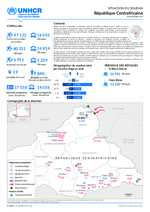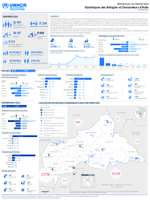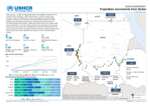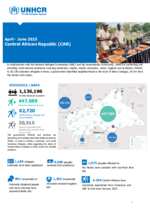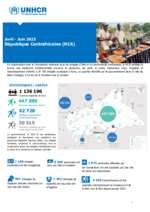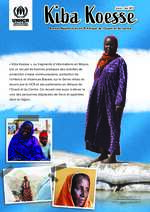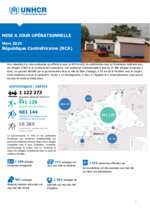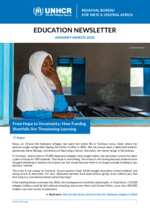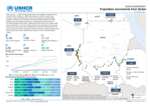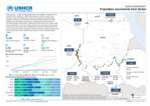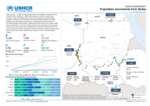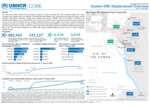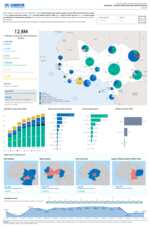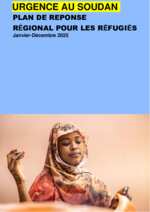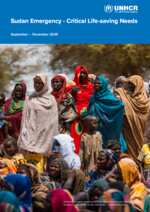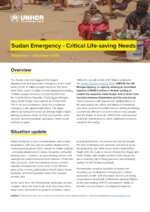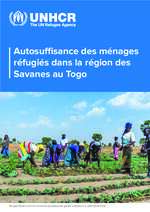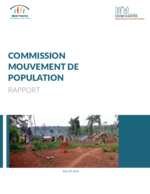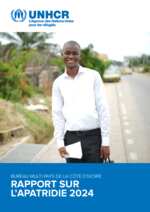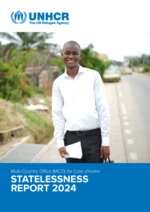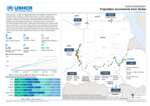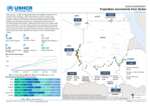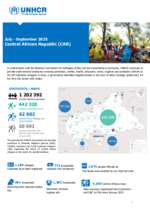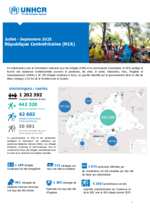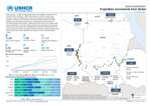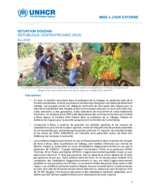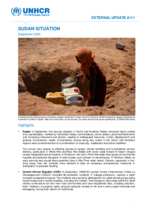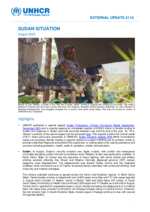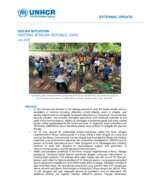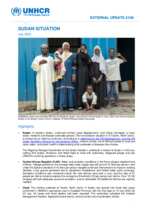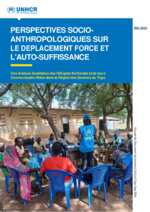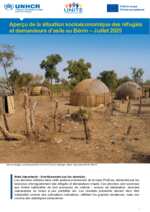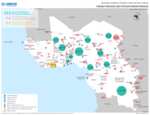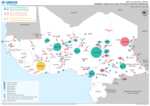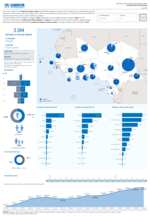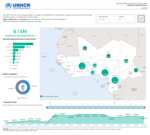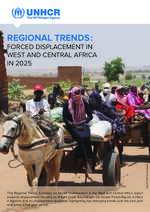| Country of origin | Source | Data date | Population | |
|---|---|---|---|---|
| Sudan | Government, UNHCR | 30 Sep 2025 | 72.3% | 39,026 |
| Dem. Rep. of the Congo | Government, UNHCR | 30 Sep 2025 | 11.7% | 6,336 |
| Chad | Government, UNHCR | 30 Sep 2025 | 9.2% | 4,987 |
| South Sudan | Government, UNHCR | 30 Sep 2025 | 6.0% | 3,256 |
| Various | Government, UNHCR | 30 Sep 2025 | 0.7% | 394 |
- Todos los documentos (2192)
- 3W (1)
- Actas de reuniones (4)
- Actualizaciones (34)
- Actualizaciones de situaciones (278)
- CORE (27)
- COVID-19 (43)
- Comunicación con las comunidades (3)
- Comunicados de Prensa (6)
- Datos y estadísticas (100)
- Documentos 3RP (5)
- Documentos RRP Regionales (14)
- Documentos de estrategia (28)
- Evaluaciones (34)
- Financiamiento (106)
- Informes (110)
- Informes / Actualizaciones de Situación (426)
- Informes de Situación (379)
- Informes y documentos sobre políticas (21)
- Informes y evaluaciones (38)
- Mapas y datos geográficos (424)
- National Refugee Response Plans (2)
- Orientación (4)
- Panel de indicadores y hojas informativas (614)
- Perfiles de sitios (2)
- Planes de Respuesta regional (6)
- Protection Brief (1)
- Sin categoría (26)
- Todos los documentos (2192)
- 3W (1)
- Actas de reuniones (4)
- Actualizaciones (34)
- Actualizaciones de situaciones (278)
- CORE (27)
- COVID-19 (43)
- Comunicación con las comunidades (3)
- Comunicados de Prensa (6)
- Datos y estadísticas (100)
- Documentos 3RP (5)
- Documentos RRP Regionales (14)
- Documentos de estrategia (28)
- Evaluaciones (34)
- Financiamiento (106)
- Informes (110)
- Informes / Actualizaciones de Situación (426)
- Informes de Situación (379)
- Informes y documentos sobre políticas (21)
- Informes y evaluaciones (38)
- Mapas y datos geográficos (424)
- National Refugee Response Plans (2)
- Orientación (4)
- Panel de indicadores y hojas informativas (614)
- Perfiles de sitios (2)
- Planes de Respuesta regional (6)
- Protection Brief (1)
- Sin categoría (26)
CAR - SUDAN SITUATION - 08 December 2025
DocumentCreate date: 8 December 2025 (2 days ago)
RCA - SITUATION DU SOUDAN - 08 Decembre 2025
DocumentCreate date: 8 December 2025 (2 days ago)
Sudan Situation Map Weekly Regional Update - 01 DEC 2025
DocumentCreate date: 5 December 2025 (5 days ago)
RCA DASHBOARD REFUGIES & DEMANDEURS D'ASILE - 30 Novembre 2025
DocumentCreate date: 3 December 2025 (7 days ago)
Sudan Situation Map Weekly Regional Update - 24 Nov 2025
DocumentCreate date: 28 November 2025 (12 days ago)
Sudan Situation Map Weekly Regional Update - 17 Nov 2025
DocumentCreate date: 21 November 2025 (20 days ago)
3W Cluster Protection_RCA
DocumentCreate date: 10 August 2021 (4 years ago)
Recommendations_Regional conference on solutions in the context of forced displacement related to the Central African Republic crisis
DocumentCreate date: 28 April 2022 (3 years ago)
Déclaration de Yaoundé sur les solutions dans le cadre des déplacements forcés liés à la crise centrafricaine
DocumentCreate date: 28 April 2022 (3 years ago)
Recommandations_Réunion régionale sur les solutions dans le cadre des déplacements forcés liés à la crise centrafricaine
DocumentCreate date: 28 April 2022 (3 years ago)
Yaounde Declaration on Solutions in the context of Forced Displacement related to the Central African Republic Crisis
DocumentCreate date: 28 April 2022 (3 years ago)
OPERATIONAL UPDATE - Central African Republic - April-June 2025
DocumentCreate date: 2 October 2025 (2 months ago)
UNHCR CAR Operational Update June 2025
DocumentCreate date: 2 September 2025 (3 months ago)
HCR RCA Mise à jour opérationnelle Juin 2025
DocumentCreate date: 2 September 2025 (3 months ago)
Bureau regional de l'Afrique de l'Ouest et du Centre - Kiba Koesse - CBP/GBV/CP Newsletter Janvier-Juin 2025
DocumentCreate date: 2 July 2025 (5 months ago)
HCR RCA Mise à jour opérationnelle Mars 2025
DocumentCreate date: 22 April 2025 (7 months ago)
UNHCR Regional Bureau for West and Central Africa - Education Newsletter Q1 2025
DocumentCreate date: 14 April 2025 (7 months ago)
CAR - SUDAN SITUATION - 08 December 2025
DocumentCreate date: 8 December 2025 (2 days ago)
RCA - SITUATION DU SOUDAN - 08 Decembre 2025
DocumentCreate date: 8 December 2025 (2 days ago)
Sudan Situation Map Weekly Regional Update - 20 Oct 2025
DocumentCreate date: 22 October 2025 (1 month ago)
Sudan Situation Map Weekly Regional Update - 13 Oct 2025
DocumentCreate date: 15 October 2025 (1 month ago)
OPERATIONAL UPDATE - Central African Republic - April-June 2025
DocumentCreate date: 2 October 2025 (2 months ago)
Sudan Situation Map Weekly Regional Update - 22 Sep 2025
DocumentCreate date: 23 September 2025 (2 months ago)
CORE - Eastern DRC Situation Dashboard - 24th June 2025
DocumentCreate date: 26 June 2025 (5 months ago)
CORE - Eastern DRC Situation Overview - 13 May 2025
DocumentCreate date: 15 May 2025 (6 months ago)
Sudanese Refugees and Asylum-Seekers in Libya - 08 Dec 2024
DocumentCreate date: 9 December 2024 (1 year ago)
RB EHAGL | CORE - Population Movement from Sudan as of 25 August 2023
DocumentCreate date: 27 August 2023 (2 years ago)
RCA - SITUATION D’URGENCE AU SOUDAN - 21 Août 2023
DocumentCreate date: 21 August 2023 (2 years ago)
RB EHAGL | CORE - Population Movement from Sudan as of 17 August 2023
DocumentCreate date: 19 August 2023 (2 years ago)
COVID-19 Emergency Response Update #18, 1 - 30 April
DocumentCreate date: 26 May 2021 (4 years ago)
UNHCR MENA COVID-19 Emergency Response Update #17, 1 - 31 March 2021
DocumentCreate date: 6 May 2021 (4 years ago)
UNHCR MENA COVID-19 Emergency Response Report, March - December 2020
DocumentCreate date: 22 April 2021 (4 years ago)
UNHCR MENA COVID-19 Emergency Response Update #16, 1 - 28 February 2021
DocumentCreate date: 21 March 2021 (4 years ago)
UNHCR MENA COVID-19 Emergency Response Update #15, 17 January 2021
DocumentCreate date: 17 February 2021 (4 years ago)
UNHCR MENA Report – COVID-19 Vaccinations: Update #1, 7 February 2021
DocumentCreate date: 7 February 2021 (4 years ago)
Bulletin sur les Solutions Durables
DocumentCreate date: 12 January 2023 (2 years ago)
UNHCR RCA - Une coopérative agricole comme outil de cohésion sociale et de réintegration des rapatriés en RCA
DocumentCreate date: 26 May 2020 (5 years ago)
UNHCR RCA - Ingrid Kinguila, un bel exemple d’intégration d’une rapatriée à Mongoumba dans la Lobaye en RCA
DocumentCreate date: 26 May 2020 (5 years ago)
Final communiqué of the first statutory ministerial meeting on CAR Solutions Support Platform
DocumentCreate date: 20 November 2023 (2 years ago)
UNHCR RBWCA | Final Communique
DocumentCreate date: 20 November 2023 (2 years ago)
UNHCR Press Release: UNHCR and partners commit to expand innovative higher education for young refugees in the region
DocumentCreate date: 1 April 2022 (3 years ago)
Communiqué de presse: Le HCR et ses partenaires s'engagent à développer l’enseignement supérieur innovant pour les jeunes réfugiés dans la r...
DocumentCreate date: 1 April 2022 (3 years ago)
HCR Afrique de l'Ouest La CEDEAO, le HCR, et la Côte d'Ivoire célèbrent les deux ans du Plan d'Action de Banjul contre l'apatridie en Afriqu...
DocumentCreate date: 28 May 2019 (6 years ago)
UNHCR West Africa Eradicating statelessness in West Africa: ECOWAS, UNHCR and Côte d'Ivoire celebrate the 2nd anniversary of the Banjul Plan...
DocumentCreate date: 28 May 2019 (6 years ago)
UNHCR RBWCA - Overview - Forcibly displaced and stateless people - June 2025
DocumentCreate date: 28 July 2025 (4 months ago)
UNHCR RBWCA - Monthly Statistics - May 2025
DocumentCreate date: 27 June 2025 (5 months ago)
UNHCR RBWCA - Monthly Statistics - April 2025
DocumentCreate date: 27 May 2025 (6 months ago)
UNHCR RBWCA - Monthly Statistics - March 2025
DocumentCreate date: 24 April 2025 (7 months ago)
UNHCR RBWCA - Monthly Statistics - February 2025
DocumentCreate date: 27 March 2025 (8 months ago)
UNHCR RBWCA - Monthly Statistics - January 2025
DocumentCreate date: 25 February 2025 (9 months ago)
RCA - PLAN DE REPONSE RÉGIONAL POUR LES RÉFUGIÉS - Janvier-Décembre 2025
DocumentCreate date: 26 June 2025 (5 months ago)
Sudan RRP 2023 - September Progress Report
DocumentCreate date: 8 November 2023 (2 years ago)
Sudan Regional Refugee Response - May-Dec 2023 (Revised Aug 2023) - At a Glance
DocumentCreate date: 4 September 2023 (2 years ago)
Sudan Regional Refugee Response - May to December 2023 (Revised August 2023)
DocumentCreate date: 4 September 2023 (2 years ago)
Sudan RRP 2023 - June Progress Report
DocumentCreate date: 18 June 2023 (2 years ago)
UNHCR Sudan Situation Supplementary Appeal - 2024
DocumentCreate date: 21 May 2024 (1 year ago)
UNHCR Sudan Situation Supplementary Appeal - 2024
DocumentCreate date: 9 February 2024 (1 year ago)
RCA - PLAN DE REPONSE RÉGIONAL POUR LES RÉFUGIÉS - Janvier-Décembre 2025
DocumentCreate date: 26 June 2025 (5 months ago)
Sudan Regional Refugee Response Plan 2025
DocumentCreate date: 4 February 2025 (10 months ago)
Sudan Regional Refugee Response 2025 - At a Glance
DocumentCreate date: 12 December 2024 (11 months ago)
Sudan Regional Refugee Response 2024 - At a Glance
DocumentCreate date: 1 February 2024 (1 year ago)
UNHCR West Africa Agenda Regional Strategic Meeting on Statelessness: West Africa on the journey towards the High-Level Segment to be held o...
DocumentCreate date: 28 May 2019 (6 years ago)
HCR Afrique de l'Ouest Note Conceptuelle Réunion régionale stratégique sur l’apatridie : L’Afrique de l’Ouest en marche vers le Segment de h...
DocumentCreate date: 28 May 2019 (6 years ago)
HCR Afrique de l'Ouest Agenda Réunion régionale stratégique sur l’apatridie : L’Afrique de l’Ouest en marche vers le Segment de haut niveau ...
DocumentCreate date: 28 May 2019 (6 years ago)
UNHCR West Africa Concept Note Regional Strategic Meeting on Statelessness: West Africa on the journey towards the High-Level Segment to be ...
DocumentCreate date: 28 May 2019 (6 years ago)
Allocation sur la réserve d’urgence du FH RCA - Soutien au retour des personnes déplacées à Bangui Mars 2017
DocumentCreate date: 12 April 2017 (8 years ago)
Programme d’appui à la résilience en République centrafricaine
DocumentCreate date: 12 April 2017 (8 years ago)
Accès au Numérique, Besoins en Communication et Pratiques Communautaires
DocumentCreate date: 8 March 2021 (4 years ago)
The Primacy of Protection: Delivering on the MINUSCA Mandate in the Central African Republic
DocumentCreate date: 12 April 2017 (8 years ago)
Aperçu des besoins en milieu rural dans les préfectures du Mbomou et Haut Mbomou Sous-préfectures de Rafaï, Zémio et Obo - Axes Zémio – Rafa...
DocumentCreate date: 12 April 2017 (8 years ago)
Border Control from Hell: How the EU's migration partnership legitimizes Sudan's "militia state"
DocumentCreate date: 12 April 2017 (8 years ago)
Territoire Morcelé, Communautés Divisées: La République Centrafricaine face à des menaces sécessionnistes
DocumentCreate date: 16 February 2017 (8 years ago)
Dangerous Divisions: The Central African Republic faces the threat of secession
DocumentCreate date: 16 February 2017 (8 years ago)
UNHCR Sudan Situation Supplementary Appeal - 2024
DocumentCreate date: 21 May 2024 (1 year ago)
UNHCR Sudan Situation Supplementary Appeal - 2024
DocumentCreate date: 9 February 2024 (1 year ago)
Central African Republic Situation Funding Update 24 March 2021
DocumentCreate date: 29 March 2021 (4 years ago)
Central African Republic Situation Funding Update 02 March 2021
DocumentCreate date: 8 March 2021 (4 years ago)
West and Central Africa Funding Update - 14 October 2020
DocumentCreate date: 16 October 2020 (5 years ago)
UNHCR Central African Republic Situation Funding Update 22 October 2019
DocumentCreate date: 22 October 2019 (6 years ago)
Sudan Emergency: Critical Life-saving Needs (September – December 2025)
DocumentCreate date: 22 September 2025 (2 months ago)
Sudan Emergency: Critical Life-saving Needs (September – December 2025) At a Glance
DocumentCreate date: 22 September 2025 (2 months ago)
Autosuffisance des ménages réfugiés dans la région des Savanes au Togo
DocumentCreate date: 7 November 2025 (1 month ago)
RCA - Rapport narratif CMP Juillet 2025
DocumentCreate date: 29 August 2025 (3 months ago)
Rapport sur l'apatridie 2024
DocumentCreate date: 29 August 2025 (3 months ago)
Statelessness Report 2024
DocumentCreate date: 29 August 2025 (3 months ago)
Sudan Situation Map Weekly Regional Update - 10 Nov 2025
DocumentCreate date: 14 November 2025 (26 days ago)
Sudan Situation Map Weekly Regional Update - 03 Nov 2025
DocumentCreate date: 10 November 2025 (1 month ago)
OPERATIONAL UPDATE - Central African Republic - July - September 2025
DocumentCreate date: 3 November 2025 (1 month ago)
HCR RCA Mise à jour opérationnelle Juillet - Septembre 2025
DocumentCreate date: 3 November 2025 (1 month ago)
Sudan Situation Map Weekly Regional Update - 27 Oct 2025
DocumentCreate date: 31 October 2025 (1 month ago)
Situation Soudan - Mise à jour Externe - HCR RCA - Août 2025
DocumentCreate date: 24 October 2025 (1 month ago)
Sudan Situation: UNHCR Monthly External Update #111 - September 2025
DocumentCreate date: 31 October 2025 (1 month ago)
Sudan Situation: UNHCR Monthly External Update #110 - August 2025
DocumentCreate date: 22 October 2025 (1 month ago)
Sudan Emergency: Critical Life-saving Needs (September – December 2025)
DocumentCreate date: 22 September 2025 (2 months ago)
Sudan Emergency: Critical Life-saving Needs (September – December 2025) At a Glance
DocumentCreate date: 22 September 2025 (2 months ago)
Sudan Situation: UNHCR CAR External Update: July 2025
DocumentCreate date: 1 September 2025 (3 months ago)
Sudan Situation: UNHCR Monthly External Update #109 - July 2025
DocumentCreate date: 29 August 2025 (3 months ago)
UN Policy Brief: COVID-19 and People on the Move
DocumentCreate date: 3 June 2020 (5 years ago)
Humanitarian Action for Children 2017 - West and Central Africa
DocumentCreate date: 26 January 2017 (8 years ago)
Central African Republic - Humanitarian Action for Children 2017
DocumentCreate date: 26 January 2017 (8 years ago)
République centrafricaine: Plan de réponse humanitaire 2017- 2019 (nov 2016)
DocumentCreate date: 25 January 2017 (8 years ago)
CAR 2016 RRRP French Word version
DocumentCreate date: 21 October 2016 (9 years ago)
Protocole d'accord Co-coordination du sous-cluster protection de l'enfance — République centrafricaine (RCA)
DocumentCreate date: 5 October 2016 (9 years ago)
PERSPECTIVES SOCIO ANTHROPOLOGIQUES SUR LE DEPLACEMENT FORCE ET L'AUTO-SUFFISSANCE - Mai 2025
DocumentCreate date: 1 August 2025 (4 months ago)
Profil socioéconomique des réfugiés au Togo – Juin 2025
DocumentCreate date: 1 August 2025 (4 months ago)
Aperçu de la situation socioéconomique des réfugiés et demandeurs d’asile au Bénin – Juillet 2025
DocumentCreate date: 1 August 2025 (4 months ago)
RAPPORT MONITORING DE PROTECTION - Juillet - Septembre 2022
DocumentCreate date: 18 January 2023 (2 years ago)
RCA UNHCR Monitoring Protection_Avril - Juin 2022_T2
DocumentCreate date: 6 September 2022 (3 years ago)
RCA Analyse VBG_Recommandations et actions de suivi-23-8-22
DocumentCreate date: 23 August 2022 (3 years ago)
UNHCR RBWCA - Principal Refugees, IDPs and Stateless Persons - October 2025
DocumentCreate date: 17 November 2025 (23 days ago)
UNHCR RBWCA - Principal Refugees, IDPs and Stateless Persons - September 2025
DocumentCreate date: 22 October 2025 (1 month ago)
UNHCR RBWCA - Principal Refugees, IDPs and Stateless Persons - August 2025
DocumentCreate date: 17 September 2025 (2 months ago)
UNHCR RBWCA - Overview - Forcibly displaced and stateless people - June 2025
DocumentCreate date: 28 July 2025 (4 months ago)
UNHCR RBWCA - Refugees and Asylum-seekers - June 2025
DocumentCreate date: 28 July 2025 (4 months ago)
UNHCR RBWCA - Internally Displaced Persons - June 2025
DocumentCreate date: 28 July 2025 (4 months ago)
South Sudan RRP – CAR 2018 Mid-Year Report
DocumentCreate date: 1 October 2018 (7 years ago)
South Sudan RRP – CAR 2018 Mid-Year Infographics
DocumentCreate date: 1 October 2018 (7 years ago)
Implementing the Guidelines: a Toolkit to Guide Understanding and Implementation of the Guidelines for Protecting Schools and Universities f...
DocumentCreate date: 11 April 2017 (8 years ago)
New York Declaration for Refugees and Migrants
DocumentCreate date: 13 March 2019 (6 years ago)
Cluster Education - 2014 Strategie
DocumentCreate date: 22 April 2015 (10 years ago)
Termes de référence su Cluster Education en RCA (juillet 2014)
DocumentCreate date: 22 April 2015 (10 years ago)
Sudan Situation Map Weekly Regional Update - 01 DEC 2025
DocumentCreate date: 5 December 2025 (5 days ago)
RCA DASHBOARD REFUGIES & DEMANDEURS D'ASILE - 30 Novembre 2025
DocumentCreate date: 3 December 2025 (7 days ago)
Sudan Situation Map Weekly Regional Update - 24 Nov 2025
DocumentCreate date: 28 November 2025 (12 days ago)
Sudan Situation Map Weekly Regional Update - 17 Nov 2025
DocumentCreate date: 21 November 2025 (20 days ago)
Sudan Situation Map Weekly Regional Update - 10 Nov 2025
DocumentCreate date: 14 November 2025 (26 days ago)
CAR Dashboard VolRep - Année 2017 - 31 Octobre 2025
DocumentCreate date: 10 November 2025 (1 month ago)
Central African Republic: Socioeconomic Profile - Sudan Situation - January 2025
DocumentCreate date: 28 January 2025 (10 months ago)
UNICEF CAR Humanitarian Sitrep December 2014
DocumentCreate date: 23 January 2015 (10 years ago)
Sudan Regional Refugee Response Plan 2025
DocumentCreate date: 4 February 2025 (10 months ago)
Sudan Regional Refugee Response 2025 - At a Glance
DocumentCreate date: 12 December 2024 (11 months ago)
REGIONAL TRENDS: FORCED DISPLACEMENT IN WEST AND CENTRAL AFRICA IN 2025
DocumentCreate date: 11 June 2025 (5 months ago)
The Democratic Republic of Congo Regional Refugee Response Plan (RRRP) 2019-2020 - Revised in June 2019
DocumentCreate date: 30 June 2019 (6 years ago)
The Democratic Republic of Congo Regional Refugee Response Plan (RRRP) 2019-2020
DocumentCreate date: 11 December 2018 (6 years ago)
Democratic Republic of Congo Regional Refugee Response Plan (RRRP) 2018 - Revised in May 2018
DocumentCreate date: 17 July 2018 (7 years ago)
UNHCR CAR| Protection brief Sudan situation September 2023
DocumentCreate date: 29 September 2023 (2 years ago)
CAR CMP Population Movements April 2021
DocumentCreate date: 17 May 2021 (4 years ago)
UNHCR Regional Bureau for West and Central Africa - Education Newsletter #28 - April 2021
DocumentCreate date: 10 May 2021 (4 years ago)
UNHCR Regional Bureau for West and Central Africa - Education Newsletter #27 - March 2021
DocumentCreate date: 8 April 2021 (4 years ago)
UNHCR Regional Bureau for West and Central Africa - Education Newsletter #26 - February 2021
DocumentCreate date: 4 March 2021 (4 years ago)
UNHCR Regional Bureau for West and Central Africa - Education Newsletter #25 - January 2021
DocumentCreate date: 9 February 2021 (4 years ago)
UNHCR - Closing Statement - GRF Stock-Taking Event - December 2020 - FR
DocumentCreate date: 8 January 2021 (4 years ago)
JSON
-
Central African Republic - DRC Situation
The on-going conflicts in the Democratic Republic of the Congo (DRC) have caused and continue to cause internal and external displacement of populations. In 2017, some 100,000 Congolese fled to neighbouring countries as refugees, due to widespread militia activities, unrest and violence, joining the 585,000 already in exile. The security conditions in DRC, especially in the eastern and central parts have continued to worsen since the beginning of 2018. Because of this, the Congolese refugee population is now among the ten largest in the world. Nearly 55 per cent are children, many crossing borders unaccompanied or separated. Existing camps and sites in many asylum countries are saturated, and available basic services are stretched to the limit. The situation requires support, adequate resources and collaboration so that effective protection and assistance can be delivered efficiently to Congolese refugees.
-
Central African Republic - Eradication of Statelessness in the East and Horn of Africa, and the Great Lakes Region
Highlighting statelessness in the 12 Member States of the ICGLR, and what is being done to eradicate it. Media coverage, testimonies of stateless persons, reports on the issue and all documents pertaining to the Brazzaville Declaration process can be consulted in English, French, Portuguese and Arabic.
-
Central African Republic - Sudan situation
Since the start of the conflict in Sudan in mid-April, large numbers of civilians have been forced to flee, including people who were already internally displaced and refugees from other countries who had sought safety in Sudan. Hundreds of thousands of people have fled into neighbouring countries or returned home in adverse circumstances – notably to the Central African Republic, Chad, Egypt, Ethiopia and South Sudan. Others self-relocated within Sudan.
- Central African Republic - Eradication of Statelessness in the West and Central Africa Region
-
Central African Republic - Regional Bureau for West and Central Africa
With ongoing crises in the Central African Republic (CAR), Mali, Nigeria, and the Democratic Republic of the Congo (DRC), as well as increased insecurity in Burkina Faso, approximately 14 million people are internally displaced across the region. In this challenging context, UNHCR will assume its leadership role across the three clusters, provide direct assistance to internally displaced persons (IDPs), ensure that protection remains at the center of the multi-stakeholder humanitarian response, and work towards solutions in coordination with all partners, including key development actors. “The West and Central Africa region faces multiple humanitarian and development challenges. However, this has not prevented its governments and people from showing solidarity with over 21 million asylum seekers, refugees, and internally displaced persons. To ensure sustainability, this solidarity needs to be supported by adequate funding,” said Mr. Abdouraouf Gnon Konde, Regional Bureau Director.
-
Central African Republic - Central African Republic Regional Response
The dire crisis in the Central African Republic continues to trigger massive forced displacement, increasing pressure on resources and living conditions in host communities and countries. Intense militia activity and inter-community violence hampers humanitarian access and exposes civilians to serious protection risks. According to OCHA, CAR remains the country with the highest humanitarian needs per capita, with 50 per cent of the population having to rely on humanitarian assistance to survive, while 25 per cent is displaced either internally or in a neighbouring country.

